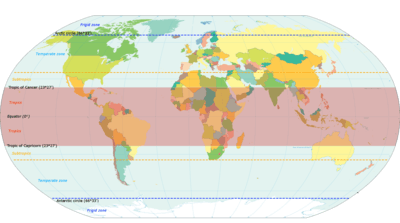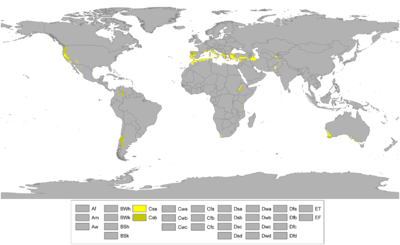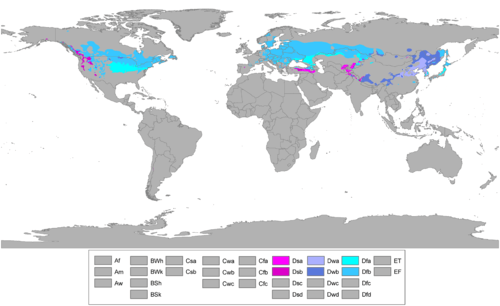Temperate climate

.svg.png)
In geography, the temperate or tepid climates of Earth occur in the middle latitudes, which span between the tropics and the polar regions of Earth.[1] These zones generally have wider temperature ranges throughout the year and more distinct seasonal changes compared to tropical climates, where such variations are often small.
The temperate zones (latitudes from 35° to the polar circles at about 66.5°, north and south) are where the widest seasonal changes occur, with most climates found in it having somewhat balanced influence from both the tropics and the poles. The subtropics (latitudes from about 23.5° to 35°, north and south) have temperate climates that show further similarities with the tropics, usually having warmer summers and milder winters. The poleward outskirts of the temperate zone, is where the coldest but yet temperate climates such as the boreal climate are found, with colder winters and milder summers, showing further similarities with the poles.
It must be reminded that not only latitudinal positions influence temperature changes and that sea currents, air masses, continentality, maritimity, and altitude will also be defining factors, with climates considered temperate being found even in tropical areas or milder climates in polar regions. Humidity and precipitation changes are also taken into account.
The Köppen climate classification defines a climate as "temperate" when the coldest month has a mean temperature above −3 °C (26.6 °F) but below 18 °C (64.4 °F).[2][3]
Zones and climates
The north temperate zone extends from (approximately 23.5° north) to the Arctic Circle (approximately 66.5° north latitude). The south temperate zone extends from (approximately 23.5° south) to the Antarctic Circle (at approximately 66.5° south).[4][5]
In some climate classifications, the temperate zone is often divided into several smaller climate zones, based on monthly temperatures, the coldest month, and rainfall. These include humid subtropical climate, Mediterranean climate, oceanic, and continental climate.
Humid subtropical climates

Subtropical climates are generally located between 23.5° and 35° north or south on the eastern or leeward sides of landmasses. This climate has long hot summers, and short, mild winters, with annual rainfall often concentrated in the warmest part of the year. These climates may occur in southern Asia, the southeastern United States, parts of eastern Australia, and in eastern coastal South America.
Dry-winter subtropical climates
This is a variant of the Subtropical climate that experiences a much drier winter. Similar in characteristic to the Mediterranean Climate which is also a Subtropical Climate with a dry season, in this case a dry summer. The drier season is usally due to proximity towards drier continental regions, so this climate is more commonly found in the subtropical countryside, near dry areas, such as Central-West Texas.
Mediterranean climates

Dry Summer Subtropical or Mediterranean climates occur generally between 30° and 42° north and south, on the western sides of landmasses. This climate has warm to hot summers and short mild winters; however, seasonal rainfall is the opposite of that of the humid subtropical type, with a winter or cool season rainfall peak being typical, and summer as drier season. These climates occur near the rimlands of the Mediterranean Sea, in western and southern Australia, in the California region of North America, in southwestern South America, and in the western areas of South Africa.
Oceanic climates
The Oceanic climates occur in the higher middle latitudes, between 45° and 60° north and south. They are created by the onshore flow from the cool high latitude oceans to their west. This causes the climate to have cool summers and cool (but not cold) winters. These climates are frequently cloudy, and are fairly milder both in winter and summer in comparison to other temperate climates. Annual rainfall is spread throughout the entire year. Regions with this climate include Western Europe, northwestern North America, southeastern and southwestern South America, southeastern Australia and parts of New Zealand.

Subtropical highland climates
The subtropical highland variety of the oceanic climate exists in elevated portions of the world that are within either the tropics or subtropics, though it is typically found in mountainous locations in some tropical countries. Despite the latitude, the higher altitudes of these regions mean that the climate tends to share characteristics with oceanic climates, though it also tends to experience noticeably drier weather during the lower-sun "winter" season. It mainly occurs in elevated areas of Sub-Saharan Africa and South America, on the Andes Mountains and on the Brazilian Highlands at the southern and southeastern portions of the country, and some mountainous areas across Southern Asia.
Continental climates

The continental climates occur in middle latitudes, between 40° and 65° north or south. These climates are normally inland or on leeward sides of landmasses. They feature warm to hot summers and cold winters, with a large interseasonal temperature variation. Regions with this climate include northern temperate Asia, the northern United States, southern Canada, and parts of northeastern Europe.
Boreal climate

Boreal climate or subarctic climate is a climate characterised by long, usually very cold winters, and short, cool to mild summers. It is found on large landmasses, away from the moderating effects of an ocean, generally at latitudes from 50° to 70° N poleward of the humid continental climates.
Human Aspects
Demography, Fauna and Flora
The vast majority of the world's human population resides in temperate zones, especially in the Northern Hemisphere, due to its greater mass of land.[6] The biggest described number in temperate region in the world is found in southern Africa, where some 24,000 taxa (species and infraspecific taxa) have been described, but the native fauna and flora of this region does not have much cultural importance for the majority of the human population of the world that lives in Temperate Zones and that live in the Northern Hemisphere, only environmental importance.[7]
Agriculture
Farming is a large-scale practice in the temperate regions (except for Boreal/Subarctic regions) due to the plentiful rainfall and warm summers, because most agricultural activity occurs in the spring and summer, cold winters have a small effect on agricultural production. Extreme winters or summers have a huge impact on the productivity of agriculture.[8]
Urbanization
Temperate regions have the majority of the world's population, which leads to large cities. There are a couple factors why the climate of large city landscapes differs from the climate of rural areas. One factor is the strength of the absorption rate of builds and asphalt, which is higher than natural land. The other large factor is the burning of fossil fuels from buildings and vehicles. These factors have led to the average climate of cities to be warmer than surrounding areas.[8]
Misconceptions
"Temperate Climate" refers to climates between Polar and Tropical. However, there is a gradual change from polar to tropical climates across the middle latitude temperate zones. Normally the northern portions of the temperate zone feature Boreal, Continental, and Oceanic climates, while the southern portions of the temperate zone are often Mediterranean and humid subtropical climates. These different climates all fall within the temperate zone which has a basic definition as being any climate with a mean temperature above −3 °C (26.6 °F) but below 18 °C (64.4 °F) in the coldest month. Obviously winter temperatures will be more mild in southerly portions and colder in the more northerly portions of the temperate zone.
From a floristic standpoint, each of these climate zones have generally temperate vegetation. There is however, an obvious change in flora from the far northern portions of the temperate zone (Boreal) to the far southern portion (humid subtropical). Pines and conifers are endemic and more abundant in the northern portion of the temperate, while palms may be endemic to far southern portions of the temperate zone. Along with this, the humid subtropical climate may be wrongly separated from the Temperate group of climates, and further associated with the Tropical climates, much because of its name, temperatures and the vegetation found in Subtropical zones which can be somewhat similar to that of Tropical regions (For instance the Atlantic Forest of Brazil is spread across both Temperate and Tropical zones of the country). Additionally, both temperate and tropical species can be found side by side in the far southern portions of the temperate zone (for example in central Florida), while subarctic species might be found growing in northern portions of the continental zone (for example in Northwest Europe).
See also
References
- ↑ "Weather & Climate Change: Climates around the world". Education Scotland. Archived from the original on 14 April 2016.
- ↑ "Latitude & Climate Zones". The Environmental Literacy Council. Retrieved 15 July 2017.
- ↑ "Patterns of Climate". Weather-climate.org.uk. Retrieved 15 July 2017.
- ↑ McColltoll, R. W. (2005). Encyclopedia of World Geography, Volume 1. Facts on File Library of World Geography. New York: Facts on File. p. 919. ISBN 0-816-05786-9.
- ↑ "Solar Illumination: Seasonal and Diurnal Patterns". Encyclopedia.com. Retrieved 4 October 2012.
- ↑ Cohen, Joel E.; Small, Christopher (24 November 1998). "Hypsographic demography: The distribution of human population by altitude". Proceedings of the National Academy of Sciences of the United States of America. 95 (24): 14009–14014. doi:10.1073/pnas.95.24.14009. PMC 24316. PMID 9826643.
- ↑ Germishuizen, Gerrit; Meyer, N. L., eds. (January 2003). Plants of Southern Africa: An Annotated Checklist (PDF). Strelitzia. 14. Pretoria: National Botanical Institute. ISBN 978-1-919795-99-7.
- 1 2 Burroughs, William James (1999). The Climate Revealed. New York: Cambridge University Press. p. 114. ISBN 978-0-521-77081-1.